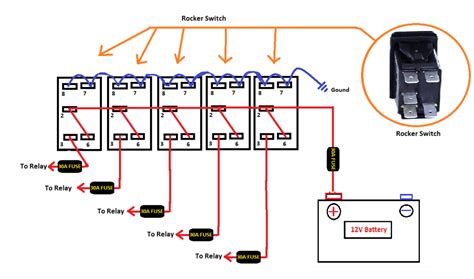How To Wire 5 Pin Rocker Switch
Ronan Farrow
Apr 03, 2025 · 3 min read

Table of Contents
How to Wire a 5-Pin Rocker Switch: A Comprehensive Guide
Wiring a 5-pin rocker switch might seem daunting, but with a clear understanding of its functionality and a step-by-step approach, it becomes a straightforward task. This guide will walk you through the process, covering everything from identifying the terminals to troubleshooting potential issues. We'll focus on common applications and provide tips for a successful installation.
Understanding the 5-Pin Rocker Switch
The 5-pin rocker switch offers greater versatility compared to its 3-pin counterpart. The extra pins allow for more complex switching arrangements, often used in scenarios requiring:
- Two independent circuits: Control two separate loads simultaneously or independently. Think of separate lights in a room, each controlled by a different position of the switch.
- Switching and illumination: One circuit controls the main load (e.g., a light), while another illuminates the switch itself, providing visual feedback even in low-light conditions.
- Momentary and maintained functions: The switch can be configured to provide momentary (only while pressed) and maintained (on/off) actions.
Identifying the Terminals
Before you begin, it's crucial to identify the terminals on your 5-pin rocker switch. While the exact layout might vary slightly depending on the manufacturer, the general arrangement is usually consistent:
- Common Terminal: This is the central terminal, often larger than the others. It's connected to the power source and is shared between both circuits.
- NO (Normally Open) Terminals: These terminals are connected to their respective loads when the switch is in the "ON" position.
- NC (Normally Closed) Terminals: These terminals are connected to their respective loads when the switch is in the "OFF" position. This is useful for applications requiring a specific state when the switch is off.
Important Note: Always refer to your switch's datasheet or markings for precise terminal identification.
Wiring Diagrams and Applications
Here are a few common wiring configurations for a 5-pin rocker switch:
Scenario 1: Controlling Two Independent Circuits
This setup allows you to independently switch on/off two separate loads. Each NO terminal controls a different circuit.
[Insert a simple wiring diagram here showing the power source, the common terminal, two NO terminals connected to separate loads (e.g., light bulbs), and the ground.]
Scenario 2: Switching with Illumination
This configuration controls one load and illuminates the switch itself. One NO terminal is for the main load, and another terminal is connected to a light to illuminate the switch.
[Insert a simple wiring diagram here showing the power source, the common terminal, one NO terminal connected to the main load, and a separate terminal connected to a small LED or bulb for illumination.]
Scenario 3: Momentary and Maintained Functions (More Advanced)
This requires a more sophisticated understanding of electrical circuits and is typically found in specialized applications. Consult detailed schematics for this type of configuration.
Step-by-Step Wiring Instructions
- Power OFF: Always disconnect power from the circuit before starting any wiring work. This is a crucial safety precaution.
- Identify Terminals: Carefully identify the common, NO, and NC terminals on your switch using the markings or datasheet.
- Connect Power: Connect the positive wire from your power source to the common terminal.
- Connect Loads: Connect the positive wires from your loads to their respective NO terminals.
- Connect Ground: Connect the negative wires from your power source and loads to the appropriate ground point.
- Test: After completing the wiring, carefully turn the power back on and test the functionality of the switch and circuits.
Troubleshooting
- Switch doesn't work: Double-check all connections for loose wires or incorrect terminal assignments. Verify that the power is supplied correctly.
- One circuit works, but not the other: Check the wiring of the non-functional circuit. There might be a broken wire or faulty connection.
Conclusion
Wiring a 5-pin rocker switch effectively requires understanding the different terminals and their roles. By carefully following this guide and taking necessary safety precautions, you'll be able to confidently install and use this versatile switch in various projects. Remember to always prioritize safety and double-check your work before turning the power back on.
Featured Posts
Also read the following articles
| Article Title | Date |
|---|---|
| How Big Is El Salvador Compared To A Us State | Apr 03, 2025 |
| How Big Is 15mm Round | Apr 03, 2025 |
| How To Wire Fog Lights Into Headlights | Apr 03, 2025 |
| Act 168 Form How To Fill Out | Apr 03, 2025 |
| How Big Are Space Marine Miniatures | Apr 03, 2025 |
Latest Posts
Thank you for visiting our website which covers about How To Wire 5 Pin Rocker Switch . We hope the information provided has been useful to you. Feel free to contact us if you have any questions or need further assistance. See you next time and don't miss to bookmark.
